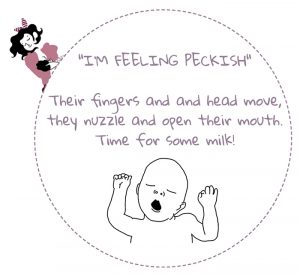If you have never breastfed before or have just begun, this chapter was written for you. Let’s be realistic, you may not find answers to all your questions here and this may leave you feeling slightly frustrated. But breastfeeding is first and foremost about trust. Trusting who? The four of you, of course! You, your breasts, your milk and Baby.

Before we start
What is the winning combo?
Les premiers jours sont très importants pour bien démarrer l’allaitement. Si vous appliquez les points-clés suivants, il y a de grandes chances que vous y arriviez les doigts dans le nez :

- During what is called « the Golden hour », it is essential to let Baby feed as soon as possible. Then regularly let Baby suckle and keep Baby near to you and your bosom.
- Cracked nipples can often discourage mums from breastfeeding. These can be avoided by using the right position (the BN position is ideal for this period) and ensuring that Baby is latched on correctly.
- Trust yourself and Baby.
- Where possible, do not give Baby a bottle. If supplementing is necessary, opt for a nursing supplementer or a cup.
- Relax and enjoy! Cakes, cuddles, rom-coms, do anything that will boost your oxytocin, your new best friend!
P.S. : Just like your birth, you can prepare for breastfeeding!
First meals
Baby’s first feed
As of birth, Baby can grasp your breast with their mouth and suckle thanks to primitive reflexes and innate suction skills. If, of course… the context permits. It may feel like « self attachment » is taking a long time, although most babies latch on by themselves in the first hour or two, it’s fine to help a bit if Baby is not getting there. Let your maternal instinct guide you and if you feel it necessary, give Baby a little help finding their way towards your nipple, this will not affect their future feeding ability. Also, do not hesitate to ask the hospital staff for more time. They tend to be very busy and try to shorten this first connection with Baby, despite its numerous benefits:
For Baby
-A warm welcome
-Colostrum cleans the intestines and supplies antibodies
For you
-Optimised mum/baby bonding
-Quicker recovery
-Lower risk of haemorrhage
-Reduced risk of engorgement
In practical terms, it couldn’t be simpler: use the BN position, perfectly suited to this occasion. Sitting comfortably in a semi-reclined position, keep Baby’s head close to your nipple, whose smell will remind them of your amniotic fluid. Then let the magic happen and enjoy. Bear in mind that babies take lots of little rests and may fall asleep after a few gulps, then wake up two minutes later.
This initial feed plays a crucial part in breastfeeding: it launches your milk production. The sooner you do it (during the first hours following birth), the more efficient it will be. If you do not have the opportunity to do so, don’t panic. You will still be able to breastfeed, provided you do plenty of skin-to-skin contact.
Giving Baby a bottle?
It is strongly discouraged in the early stages if you want to breastfeed. Compared to the breast, a teat gives more milk for less effort and Baby may refuse your breast after trying it. Is your partner/mother-in-law/aunt keen to feed Baby? Ask them to wait at least a month, while your milk supply is still being properly regulated, then try finger-feeding using a nursing supplementer or other alternatives.
If it is impossible to avoid giving a bottle, remember you can do so while respecting Baby’s physiology.
.
Aches and pains
Does it hurt?

Do not suffer in silence. Do not ever underestimate your pain, you may end up with cracked nipples, or worse. Seek guidance from the lactation consultant in your maternity ward, an IBCLC consultant or a support group (such as La Leche League) who will be able to make sense of the problem. When your breast milk comes in, it may feel painful, but this will not last. Remember that this is the first time you are putting this machine to use so it may need some time to get up and running correctly.
Bodywork from specialists such as osteopaths, acupuncturists and chiropractors can be a great help when you start breastfeeding..
Engorgement
We discuss this in the chapter about breastfeeding discomforts (p. 146), but it is very common during the first days. When your milk is coming in, with frequent yet sometimes difficult feeds, your breasts may feel very full, hard and ready to explode at any moment. If someone tells you there is nothing you can do to prevent this, please tell them to do more research: there is ALWAYS a way to ease the pain.
Here are just a few tips on how to relieve your breasts.
- The best way of preventing this is putting Baby to your breast as often as possible, this will also ensure a good milk supply.
- Therapeutic breast massage is an excellent way to relieve engorgement.
- You can also put cabbage leaves, green clay strips or cold compresses in your bra when Baby is soundly asleep and isn’t likely to feed.
When?
How will I know when Baby is hungry?
Do not wait for Baby to cry to feed them. Forget about the « feed every three hours » rule and try this method, which is a lot simpler to implement: when Baby is in your arms and starts nuzzling hopefully, put them to your breast.
Here are some other signals:



How long should Baby feed for?

This all depends on Baby and your milk storage capacity. Generally, you can expect between 8-12 feeds per day, but this is not a universal truth. If you are feeding more or less than this, make an appointment with a lactation consultant just in case.
The same applies for the duration of feeds: it all depends on Baby (as usual…). It may all be over in 10 minutes, including a burp, or maybe they need to peacefully enjoy every drop of milk and make the pleasure last for more than 45 minutes.
Bear in mind, their stomach is tiny. At birth, it is the same size as a cherry and grows to the size of a walnut by day three, a plum by day five and after two weeks it reaches the size of an egg. So, it fills up very quickly. Don’t forget that your milk can be digested in a flash and Baby may ask for more sooner than you’d expect.
Sometimes feeding is about more than just eating and Baby simply needs to be close to you. For example, if they feel lonely, thirsty, scared, in pain or need to be comforted… There are many reasons for them to latch onto your reassuring bosom.
Quantity/quality
Should I feed using one or both breasts?
This all depends on your breasts’ storage capacity. Some mothers have enough milk in one breast to fill up Baby, others need to use both. Wait for Baby to release the first breast, to put them on the other one.
Technical point: if you started on the right side during the last feed, start on the left side on the next one. Tip: take both breasts in your hands, whichever one weighs more is the one to use next.
You can also place something on your wrist of the side that you just used, a bracelet, ribbon, watch, etc.
Is my milk good enough?
Unless you follow a strict turnip-only diet, your milk is absolutely top-notch. Just like when you were pregnant, Baby gets first pick when it comes to nutrition: your milk production takes everything it needs and leaves you the leftovers. Therefore, you need to eat healthily (and a good variety of foods) without over-eating.
Don’t forget to drink plenty, otherwise you might feel rather parched.
Is Baby getting enough milk?
Isn’t it hard to know how much they actually swallow?! Thankfully, there are several little indicators to look out for to make sure Baby is eating enough… and reassure you.
- The lower jaw should move up and down during a feed. If they are feeding properly, their ears will also move.
- Listen to them swallow. Baby will only swallow once their mouth is full, after suckling several times.
- Keep track of wet nappies. Once your milk has come in, there should be at least six per day. Baby should have two to three stools per day during the first six weeks, then they may become less frequent.
- You can also weigh them. Not every 5 minutes though, once a week at the beginning, then every month, which is quite enough!
One last thing: if Baby lets go of your breast at the end of the feed, looking completely groggy, they are perfectly full.
Should I wash my breast before each feed?
There is no need to become a clean-freak when breastfeeding, one shower a day is more than enough.
Where possible, leave your breasts alone, Baby finds their natural scent pleasant and reassuring. Try not to use too many perfumed soaps and moisturisers. Firstly, since Baby may swallow them during a feed and secondly, mummy’s scent is Baby’s favourite.
Don’t let go!
What if someone tells me to stop?
Unless Baby is losing a lot of weight and supplementing is absolutely vital, do not let other people’s comments bring you down. Ask for a breast pump to prepare your supplements and ensure consistent milk production while your body gets used to breastfeeding or to find out what the problem really is.

These excerpts are from My completely illustrated Breastfeeding Book.




